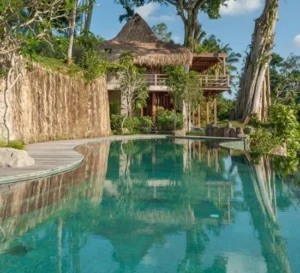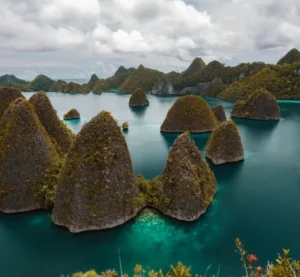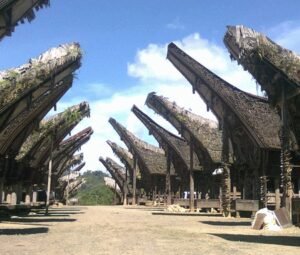Indonesia
Three time zones across the archipelago:
WIB: UTC+7 (Java, Sumatra)
WITA: UTC+8 (Bali, Sulawesi, Kalimantan)
WIT: UTC+9 (Papua, Maluku)
Indonesian Rupiah (IDR)
Symbol: Rp
Notes come in denominations of 1,000 to 100,000 rupiah
August 17, 1945 (from the Netherlands)
Independence Day (Hari Kemerdekaan) is a major national holiday
The world's largest archipelagic country with 17,000+ islands
Visa-free entry for many nationalities (30 days)
Visa on arrival option (30 days, extendable once)
E-visa and traditional visa options available
Culture
Indonesia's culture is a colorful tapestry woven from the traditions of its 17,000+ islands and more than 300 ethnic groups, creating one of the world's most diverse cultural landscapes. The national motto "Bhinneka Tunggal Ika" (Unity in Diversity) reflects how this archipelagic nation embraces its multifaceted heritage while maintaining a unified identity.
Key elements of Indonesian culture include:
- Religious diversity: Indonesia is home to the world's largest Muslim population (approximately 87%), but recognizes six official religions: Islam, Protestantism, Catholicism, Hinduism, Buddhism, and Confucianism. Hindu traditions dominate in Bali, while indigenous beliefs persist in remote areas. This religious plurality is reflected in architecture, festivals, and daily life.
- Traditional arts: Indonesia has incredible artistic traditions including batik (wax-resist dyeing recognized by UNESCO), wayang puppet theater, gamelan orchestral music, woodcarving, and intricate metalwork. Each region boasts its own distinctive art forms, such as Balinese dance, Javanese shadow puppets, and Sumatran songket weaving.
- Languages: While Bahasa Indonesia serves as the official national language and lingua franca, more than 700 living languages are spoken across the archipelago. Major regional languages include Javanese, Sundanese, Batak, and Balinese, each with its own literature and cultural expressions.
- Architecture: Traditional Indonesian architecture varies dramatically by region, from the iconic Minangkabau rumah gadang houses with their curved roof structures in West Sumatra to the elaborate Hindu temples of Bali and the distinctive tongkonan houses of Toraja with their boat-shaped roofs.
- Traditional clothing: Special occasions call for traditional attire, which varies widely by region. Common elements include batik and ikat textiles, the kebaya (fitted lace blouse) for women, and the peci (black cap) for men, particularly during formal or religious events.
Indonesia's diverse culinary traditions reflect regional ingredients, historical influences, and local tastes. While rice serves as a staple throughout much of the country, cooking styles and flavor profiles vary significantly:
- Javanese cuisine: Often sweet and savory, featuring dishes like nasi gudeg (young jackfruit stew with coconut milk) and ayam goreng (fried chicken with spices)
- Padang cuisine: From West Sumatra, known for its fiery flavors and distinctive serving style where dozens of small dishes are stacked on the table
- Balinese cuisine: Featuring complex spice pastes and ceremonial dishes like babi guling (suckling pig)
- Popular national dishes: Nasi goreng (fried rice), satay (grilled meat skewers), gado-gado (vegetable salad with peanut sauce), and rendang (slow-cooked spicy meat, named the "World's Most Delicious Food" by CNN)
- Unique ingredients: Tempeh (fermented soybean cake), terasi (shrimp paste), kecap manis (sweet soy sauce), and an abundance of fresh spices like galangal, lemongrass, and candlenuts
Community spirit (gotong royong) remains central to Indonesian culture, seen in collective decision-making, community projects, and ceremonial events. Despite rapid urbanization and modernization, traditional values around family, respect for elders, and communal harmony continue to shape Indonesian society, alongside growing global influences, particularly in urban centers like Jakarta and Surabaya.
Tourism & Best Sites to Visit
Indonesia offers extraordinary diversity for travelers, from ancient temples and pristine beaches to vibrant cities and unique wildlife encounters. Spanning three time zones and thousands of islands, the country presents vastly different experiences depending on where you visit.
Here are some of Indonesia's most remarkable destinations:





Borobudur Temple: The world's largest Buddhist temple, dating from the 9th century. This UNESCO World Heritage site features nine stacked platforms adorned with 2,672 relief panels and 504 Buddha statues. Visiting at sunrise offers a magical experience as the mist rises around the temple complex against the backdrop of volcanoes.
Ubud: The cultural heart of Bali, surrounded by rainforests and terraced rice paddies. Beyond its famous Monkey Forest Sanctuary, Ubud offers vibrant traditional arts, craft villages, ancient temples, and a thriving wellness scene. The town gained international fame after being featured in the book and film "Eat, Pray, Love."
Komodo National Park: Home to the prehistoric Komodo dragon, the world's largest lizard. This UNESCO site encompasses numerous islands with pink beaches, pristine coral reefs, and diverse marine life. Visitors can combine wildlife viewing with world-class diving and snorkeling experiences.
Raja Ampat: Located off the northwest tip of Papua, this remote archipelago is considered the epicenter of marine biodiversity, with over 1,500 fish species and 75% of the world's known coral species. Its landscapes feature jungle-covered islands, hidden lagoons, and pristine beaches, making it a paradise for divers and nature lovers.
Tana Toraja: A highland region known for its unique culture and elaborate funeral ceremonies that can last for days. The distinctive boat-shaped houses (tongkonan) with colorful carvings and soaring roofs punctuate the lush landscape. The area offers insight into one of Indonesia's most fascinating cultural traditions.
Other remarkable destinations include the colonial architecture and vibrant street life of Yogyakarta; the active volcanoes of Bromo-Tengger-Semeru National Park; the orangutan sanctuaries of Borneo; the spice islands of Maluku; Lake Toba, the world's largest volcanic lake; and the iconic Kuta Beach in Bali for surfing enthusiasts.
Transportation
Navigating Indonesia's vast archipelago presents unique challenges and adventures, often requiring combinations of air, sea, and land transportation. The country has invested significantly in its transportation infrastructure, though connectivity varies greatly between major islands and remote areas.
- Domestic flights: The most efficient way to travel between Indonesia's major islands. Airlines like Garuda Indonesia (the national carrier), Lion Air, Citilink, Batik Air, and AirAsia connect major cities and many smaller destinations. Flight networks are dense, particularly in Java, Sumatra, Kalimantan, Sulawesi, and Bali. Given the country's geography, air travel is often the only practical option for covering longer distances.
- Ferries and boats: An extensive network of ferry services connects the islands, ranging from large PELNI passenger ships that travel long-distance routes to smaller local ferries for short island hops. In tourist areas like the Gili Islands near Lombok, fast boats offer convenient transfers. For budget travelers with time flexibility, these sea routes provide an authentic experience of Indonesian life.
- Trains: Java has the most developed rail network, with comfortable and efficient services connecting major cities including Jakarta, Bandung, Yogyakarta, and Surabaya. Sumatra has limited railway services. Train travel offers a scenic way to experience the Javanese countryside and is often more reliable than road transportation on this densely populated island.
- Buses: Extensive bus networks operate on the major islands, ranging from basic local services to luxurious long-distance coaches with air conditioning and entertainment systems. In Java and Sumatra, buses reach virtually every town and village. Night buses are common for longer routes.
-
Urban transport: Major cities offer various options:
- Jakarta has an expanding MRT (subway) system, Transjakarta bus network, and commuter trains
- Ride-hailing apps like Gojek and Grab are widely used in urban areas, offering car and motorcycle taxi (ojek) services
- Traditional forms of transport include becak (cycle rickshaws) and horse carts in certain cities
Transportation tips: Consider these factors when planning travel in Indonesia:
- Book domestic flights in advance during high season (June-August) and holiday periods
- Allow buffer time when making connections, as delays are common with all forms of transport
- Download transportation apps like Traveloka, Gojek, and Grab to simplify bookings and local travel
- Ferry schedules can change based on weather conditions, particularly during monsoon season
- Traffic congestion in major cities, especially Jakarta, can significantly impact travel times
Safety considerations: While transportation infrastructure continues to improve, safety standards can vary. Choose reputable airlines for domestic flights, check the condition of boats before boarding (particularly smaller vessels), and be selective about overnight bus operators. During busy holiday periods like Eid al-Fitr (Lebaran), transportation systems throughout Indonesia become extremely crowded as millions travel to their hometowns.
Airports
Indonesia has over 250 airports spread across its archipelago, ranging from modern international facilities to small airstrips serving remote islands. The country's major international gateways provide essential connectivity for this island nation.
- Soekarno-Hatta International Airport (CGK): Located in Tangerang, about 20 km from central Jakarta, this is Indonesia's busiest airport and the main gateway to the country. Terminal 3, which serves primarily international and Garuda Indonesia flights, is the newest and most modern facility. The airport has excellent connections to destinations throughout Asia, the Middle East, Europe, and Australia.
- Ngurah Rai International Airport (DPS): Located in Denpasar, Bali, this is Indonesia's second-busiest airport and the main entry point for tourists visiting the country's most popular destination. The airport was extensively renovated in 2013 and features modern facilities with traditional Balinese architectural elements. It offers direct flights to many Asian cities and some long-haul destinations in Europe and the Middle East.
- Juanda International Airport (SUB): Serving Surabaya, Indonesia's second-largest city, this airport is an important hub for eastern Java and domestic connections to eastern Indonesia. It handles both international and domestic flights.
- Kualanamu International Airport (KNO): Located near Medan in North Sumatra, this modern airport opened in 2013 and serves as the main gateway to Sumatra. It has good connections to Malaysia and Singapore, as well as domestic destinations.
- Other significant international airports: Sultan Hasanuddin International Airport in Makassar (Sulawesi), Lombok International Airport, Sam Ratulangi International Airport in Manado (North Sulawesi), and Sultan Syarif Kasim II International Airport in Pekanbaru (Sumatra).
Airport Transportation: Options for reaching your destination from major airports include:
- Soekarno-Hatta Airport (Jakarta): The airport is connected to downtown Jakarta by the Airport Rail Link, Damri airport buses, and taxis. Ride-hailing apps like Gojek and Grab also operate from designated pickup points.
- Ngurah Rai Airport (Bali): Taxis with fixed rates to various destinations in Bali are available at the official counter. Some hotels offer airport transfers, and ride-hailing services operate from designated areas.
- Regional airports: Most have taxi services available, though in smaller destinations, it's advisable to arrange airport transfers through your accommodation in advance.
Important notes: During high season and around national holidays, airports can become extremely busy. Allow extra time for check-in and immigration procedures, particularly at Jakarta and Bali. For domestic flights, many airlines enforce strict baggage weight limits, with excess baggage fees that can be substantial. When departing from Indonesia, there is a departure tax, but this is typically included in the price of your airline ticket.
Visa & Travel Information
Indonesia has implemented various visa policies to encourage tourism while maintaining appropriate immigration controls. The options available to travelers depend on nationality, purpose of visit, and intended length of stay.
Visa Options by Nationality
The following table outlines the main entry options for visitors to Indonesia:
| Nationality | Entry Option | Duration |
|---|---|---|
| Most Western Countries, Many Asian Countries (170+ nationalities) | Visa-Free | 30 days (non-extendable) |
| Many Nationalities | Visa on Arrival | 30 days (extendable once for another 30 days) |
| ASEAN Countries | Visa-Free | 30 days (rules vary by nationality) |
| Countries not eligible for visa-free or VOA | Visa Required | Depends on visa type |
| All Nationalities (longer stays) | Social-Cultural Visa | 60 days (extendable up to 6 months) |
Visa on Arrival (VOA): Available at designated airports and seaports for eligible nationalities. It costs approximately $35 USD (or equivalent in other currencies) and can be paid by card at major entry points. The VOA can be extended once for an additional 30 days by visiting an immigration office.
E-Visa: Indonesia has introduced an e-visa system for certain visa types, allowing online application before travel. This streamlines the process for business visas, social-cultural visas, and other specialized visa categories.
Entry points: Visa-free and VOA entries are only available at designated international entry points. If you plan to enter Indonesia through a smaller port or border crossing, verify in advance whether these visa facilities are available.
Important Travel Considerations
- Passport validity: Your passport must be valid for at least 6 months beyond your intended departure date from Indonesia and have at least one blank page.
- Proof of onward travel: Immigration may request evidence of your plans to leave Indonesia before your visa expires, such as a return or onward ticket.
- Health considerations: No specific vaccinations are mandatory for entry, though travelers are advised to be up-to-date on routine vaccinations. Consider hepatitis A, typhoid, and Japanese encephalitis vaccines depending on your itinerary. Malaria prophylaxis may be recommended for certain regions, particularly in eastern Indonesia.
- Safety: Indonesia is generally safe for tourists, though natural disasters (volcanoes, earthquakes, tsunamis) are potential risks. Petty crime can occur in tourist areas, so maintain awareness of your belongings. Check travel advisories for specific regions, as some areas (particularly in Papua) have ongoing security concerns.
Best time to visit: Indonesia's climate is tropical with distinct wet and dry seasons:
- Dry season (May to September): Generally considered the best time to visit most of Indonesia, with lower humidity and rainfall. This is high season for tourism, particularly in Bali and Java.
- Wet season (October to April): Characterized by brief, heavy downpours rather than continuous rain. This period offers advantages including fewer tourists, lusher landscapes, and better deals on accommodation.
- Regional variations: The climate varies across the archipelago - parts of Sulawesi, Papua, and Maluku have different rainfall patterns, so research specific destinations when planning.
Cultural etiquette: Indonesia is generally conservative, particularly in rural areas and outside of tourist centers like Bali. Dress modestly when visiting religious sites or local communities. Remove shoes before entering homes and some shops. Use your right hand for eating and passing objects. Public displays of affection are frowned upon in most regions.
Communication: Getting a local SIM card is straightforward and affordable. Major providers include Telkomsel, XL Axiata, and Indosat with good coverage in populated areas. Wi-Fi is widely available in hotels, cafes, and restaurants in tourist destinations and cities, though connection speeds vary.